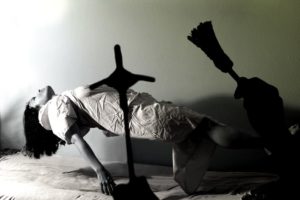Hanging Between Heaven and Hell: Exorcisms on the Rise

I was fourteen years old when I saw The Exorcist for the first time. My best friend’s older brother brought the movie home on a rented VCR tape, and we watched with nail-biting terror. I didn’t sleep for weeks after, and even now when I drive by the famous stairs in Georgetown, I can’t help but look. Watching the film as a young evangelical, I believed everything I was seeing was real; I had been taught that demon possession was a very factual danger.
But that was rural Arkansas, 1986. And now it’s nearly 2018. Surely belief in that kind of Hollywood paranormal nonsense is declining as quickly as the number of “nones” is increasing. But, believe it or not, there is actually a worldwide increase in exorcisms hiding inside a world of self-driving cars, artificial intelligence, photographs of other galaxies, and genetic manipulations. It spans religions, countries, and continents.
Just two weeks ago, a nurse in Oklahoma was fired for trying to exorcise a mentally ill, epileptic prisoner, who died the next day from medical complications. The Catholic Church also recently published Exorcisms and Related Supplications, which is an English translation of the church’s official exorcism ritual. Although this translation is only intended to be used by Catholic-endorsed and trained exorcists, one can be sure it will find its way to the internet. Even some well-educated, respected psychiatrists are getting into the act. Take Richard E. Gallagher, MD, a board-certified psychiatrist and associate professor of Clinical Psychiatry at New York Medical College. He’s also on the faculty of the Columbia University Psychoanalytic Institute, is a Phi Beta Kappa graduate of Princeton University (magna cum laude in Classics), and is trained in psychiatry at the Yale University School of Medicine. Not exactly the kind of guy you imagine fighting demons like Buffy and her friends.
Jokes aside, exorcisms are not silly, harmless rituals. People actually die. Many a murder or case of child abuse has been found to be either the tragic result of a benevolent exorcism or the actions of a mother “possessed.” Women and children seem to be the primary targets for demons. In fact, in an article last year an Islamic exorcist warned that beautiful women were much more likely to be possessed by demons than anyone else.
In all of my research, sifting through news stories, crime reports, and reading exorcists’ accounts—many of which are written by the Catholic Church—I have yet to find one account of a demon-possessed man. According to a report by the French newspaper Le Monde, those requesting exorcism come from all social and class backgrounds, and “75 percent are women—a very large majority of whom have been victims of sexual abuse (rape, incest, etc.).” Now, there are biblical stories of men being possessed, like the book of Matthew’s ”demons and the pigs” story, or the demon-possessed man Jesus restores in the book of Mark. But modern demons seem to have developed a sadistic, misogynist flare.
Why, in a world where science is becoming more and more able to understand and explain mental illness, would priests be inundated by people diagnosing themselves as possessed and insisting on being given an exorcism? What are we trying to achieve by creating these nightmares for ourselves? A blame-free way to be evil? Freedom from moral restraint? Attention? A real supervillain that by its existence proves that of the real superhero?
Psychologist Eugene Subbotsky (Lancaster University, UK) has compiled a series of studies that argue that belief in magic begins in the consciousness of children (who explicitly accept it) and then persists by living in the subconscious of adults (who explicitly deny it). Perhaps this human inclination to believe in demon possession stems from our adult, unconscious belief in magic. We are overwhelmed with news about mass shootings, natural disasters, and international tragedies of all kinds. Maybe believing someone can cast a demon out of another person gives some a sense of power over all the terrible things around us. A weird, sick hope. Maybe it’s as simple as a fear of mortality combined with a subconscious belief or need to believe in magic. Or maybe it’s just a rise in sadistic people taking advantage of children, women, and the mentally ill for their own enjoyment.
The nurse in Oklahoma denied the exorcism accusations rather than claiming she was following her religious beliefs, so it’s fortunate there was no trial or drawn-out legal debate, and she was fired for her negligence. Luckily there were witnesses. But someone still died, the female inmate with both physical and mental illnesses, when perhaps she could have been helped with proper treatment.
With all that has happened in the last year, politically and otherwise, many of us feel like we do live in the Upside Down, a television alternate reality full of monsters and nightmares. But just like the heroes of Stranger Things, we must stand up and fight the monsters ourselves. We can’t wait and depend on fantasy to make us feel better about the world, or to bring us hope that some divine being will make the world a better place. We must depend on science, reason, intellectual development, and understanding to make the world better. We must make the world better with our own minds and our own hands.
We are not the playthings of gods hanging between heaven and hell. We are an advanced breed of monkeys on a minor planet of a very average star. But we can understand the universe. And that makes us something very special.
